#Phd Assignment help
Explore tagged Tumblr posts
Text
I'm so immersed in my jason grace new rome uni fic that I'm studying ancient roman law terms using this as an excuse. help.
#I'm COMMITTED fr#I become smart just for these fanfics i swear. i thank the fanfic and fandom community for my thirst for knowledge 😮💨✨#I also remember listening to latin asmrs and learning latin words for reyna and jason :) I need help fr#i hate how I feel the need to want to know EVERYTHING tho 😭 like why do I have to overthink everything#I'm not sure if I should include ancient roman law or common law for jason tho#or he could just learn both as separate classes. the roman law can come under the history category#so he has to learn a bit of everything#political science criminal law economics history civil law corporate law banking law#I'm tired. law students I have always had nothing but respect for you#I won't go TOO deep into what he's studying in the fics tho like I won't mention his lessons in the fic every 5 mins#prolly just him doing presentations and projects then and there#bc like if I go too deep in then I'll get into a writing slump again#bc info dumping is EXHAUSTING it would feel like a school assignment not a fic#pjo#pjo fandom#percy jackson#pjo series#jason grace#pjo hoo#pjo hoo toa#annabeth chase#leo valdez#piper mclean#frank zhang#hazel levesque#jason grace x y/n#jason grace fanfic#jason grace x you#jason grace x reader#࿔‧ ֶָ֢˚˖𐦍˖˚ֶָ֢ ‧࿔ elora's PhD in overthinking
89 notes
·
View notes
Text
How Does The Brain Work?
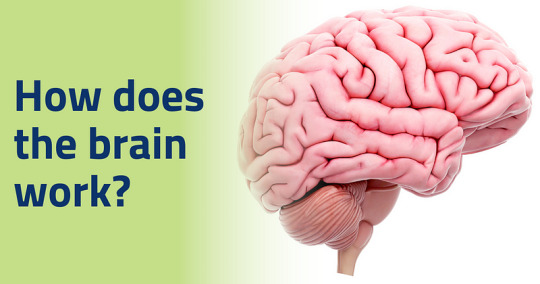
The brain stands as a marvel of biological engineering, Composing of a multitude of bodily functions ranging from cognition and memory to emotions and sensory perception. Together with the spinal cord, it constitutes the central nervous system (CNS), the command center of the human body.
Composition of the Brain
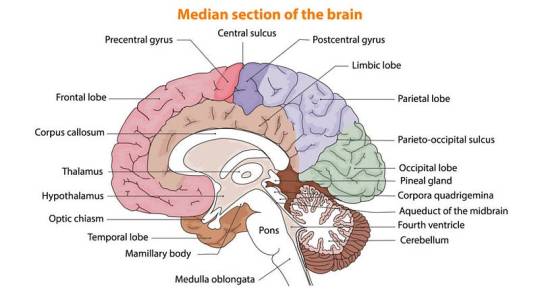
Weighing approximately 3 pounds in adults, the brain’s main structure comprises about 60% fat, interspersed with water, protein, carbohydrates, and salts. Unlike muscles, it houses a complex network of blood vessels and nerves, including neurons and glial cells.
a) Gray and White Matter
Within the central nervous system, gray matter and white matter occupies distinct regions. In the brain, gray matter forms the outer layer, rich in neuron somas, while white matter constitutes the inner section, primarily composed of axons unsheathed in myelin. Conversely, in the spinal cord, this arrangement is reversed.
b) Brain Functionality
The brain operates by transmitting and receiving chemical and electrical signals throughout the body. These signals regulate a myriad of processes, with the brain disseminating each input. Some signals remain confined within the brain, while others traverse the spinal cord and nerves, disseminating information across the body’s expanse. This composes neural network relies on billions of interconnected neurons.
Major Brain Regions and Their Functions
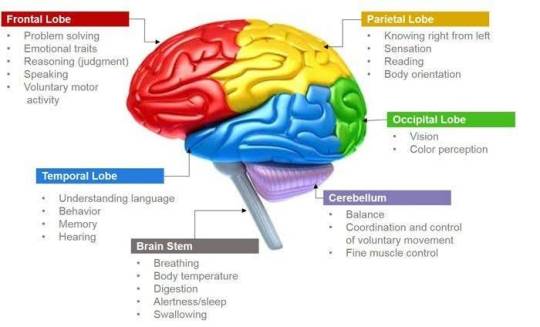
1.Cerebrum
Dominating the brain’s landscape, the cerebrum encompasses the cerebral cortex and underlying white matter. It governs a spectrum of functions, including motor coordination, temperature regulation, language processing, emotional regulation, and sensory perception.
2. Brainstem
Serving as the bridge between the cerebrum and spinal cord, the brainstem comprises the midbrain, pons, and medulla. It regulates vital autonomic functions such as heart rate, breathing, and reflexive responses.
3. Cerebellum
Nestled at the posterior aspect of the brain, the cerebellum coordinates voluntary muscle movements, posture, balance, and motor learning.
Brain Coverings
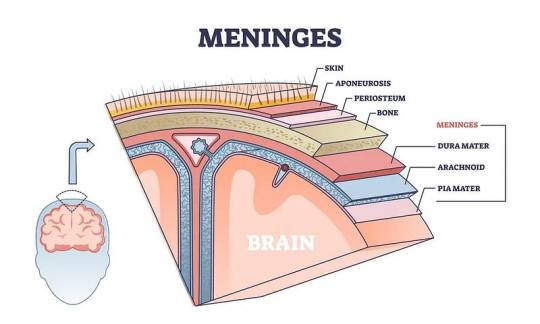
a) Meninges
Three layers of protective membranes, collectively known as meninges, enshroud the brain and spinal cord. These layers — dura mater, arachnoid mater, and pia mater — shield the delicate neural tissue from physical trauma and infection.
b) Lobes of the Brain
Each hemisphere of the brain comprises four lobes, each harboring distinct functional domains:
Frontal Lobe: Governing executive functions, motor control, and higher cognitive processes.
Parietal Lobe: Integrating sensory information, spatial awareness, and perception of pain and touch.
Occipital Lobe: Specialized for visual processing and perception.
Temporal Lobe: Involved in auditory processing, language comprehension, and memory consolidation.
Deeper Brain Structures
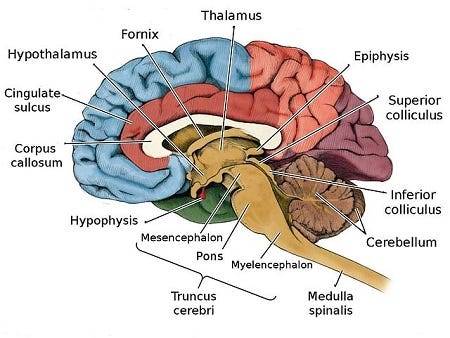
These encompass important structures such as the pituitary gland, hypothalamus, amygdala, hippocampus, and pineal gland, orchestrating hormone secretion, emotional regulation, memory consolidation, and circadian rhythms.
Blood Supply
The brain receives its oxygenated blood supply through the vertebral and carotid arteries, ensuring adequate perfusion of neural tissue. The main network of blood vessels, including the Circle of Willis, safeguards against ischemic insults and facilitates intraarterial communication.
Cranial Nerves
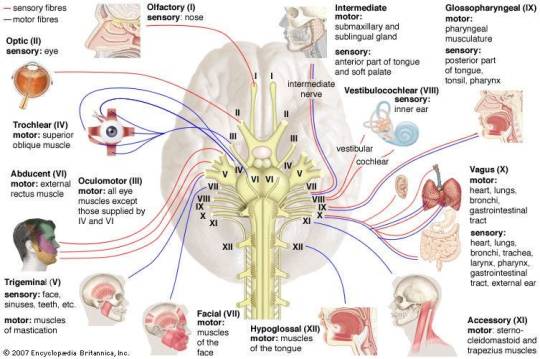
The twelve pairs of cranial nerves, originating from the brainstem, mediate a diverse array of sensory and motor functions, encompassing olfaction, vision, facial expression, and auditory perception.
Comprehending the anatomy and functionality of the brain fosters a deeper appreciation of its complexity and facilitates advances in neuroscientific research and therapeutic interventions aimed at diminishing neurological disorders.
Understanding the detailed anatomy and functionality of the brain is crucial for medical students embarking on their journey of study. Expert Academic Assignment Help offers invaluable assistance in navigating the complexities of neuroscience and related subjects. By leveraging expert guidance and support, students can excel in their medical education and contribute to advancements in the field of Medicine. Email us at [email protected] to embark on your path to scholarly excellence and professional competency.
#studying#studyblr#study blog#study aesthetic#student life#student#medical student#medical school#medicine#university student#university#university life#assignment help#medical students#nursing student#nursing school#healthcare#health and wellness#mental health#psychology#phd life#phd thesis writing service#online writing#do my online class#academic writing#essay writing#academic assignments#academia
14 notes
·
View notes
Text

🎓 Facing Overwhelming Deadlines and Complex Assignments? We get it. The life of a student is hectic, filled with pressures from numerous assignments, tight schedules, and the need for top-notch quality. Whether you're grappling with an intricate thesis, prepping for an online exam, or drowning in research papers, the academic journey can sometimes feel too heavy to navigate alone. But don’t worry because we’ve got you covered!
Reach Us: https://chat.whatsapp.com/LoPqd0DF3dJ7bBfaY9VMuJ
We Offer Expert Assignment Services in These Disciplines: 📈 Economics, 🛍 Marketing 🔒 Cyber security, 🌐 Networking 🗣 Linguistics, 📦 Supply chain ☁️ Cloud computing, ⚠️ Risk assessment and management 🥦 Food nutrition and dietetics, 👷♂️ Occupational health and safety ⚖️ Ethics, 💰 Finance and accounting 👔 Management, 🩺 Health sciences 👥 Human resource, 🌐 International relations ⚖️ Law, 📜 History 🧠 Psychology, 👥 Sociology 🕵️ Criminology, 🩺 Nursing and medicine 📊 Project Management, 📊 Supply Chain Management 💻 Computer Science, 📚 Literature 🌲 Ecology, 📺 Mass media 🩺 Nursing, ❤️🩹 Health and Social care 📘 Business studies, 🧬 Bio sciences And More…
Assignment Types: 📚 Thesis, 📖 Dissertation ✒️ Essay Writing, 💻 Online Exams 🔍 Research Paper, 📑 Project & Proposals 📜 Literature reviews, 💼 Business plans 🪞 Reflective writing, 📝 Coursework 📄 Term papers, 💬 Discussions 🎙 Class Responses, ✍️ Creative writing 🧪 Lab reports, 🎥 Presentation (PPT) creation.
Why Trust and Choose Us? 🕰 24/7 Availability, 🌟 Original and High-Quality Content 🔖 Budget-Friendly, 📈 Higher Grades Guaranteed – over 90% score 🔒 Private & Confidential
https://chat.whatsapp.com/LoPqd0DF3dJ7bBfaY9VMuJ
#college#essay#assignment help#assignmentexperts#home tutors#a+#essay writing#assignmentwriting#discussion#physics#back to school#research paper#thesis#grad school#dissertation#academics#phd#psychology#online tutoring#university#studying#exams#college life#student life#student
3 notes
·
View notes
Text
Persuasive Essay Structure: Crafting Arguments that Captivate

Persuasive essays look to convince readers to agree with your point of view or undertake actions. So, in addition to the power of your arguments, the overall structure of a persuasive essay will actually take the reader through a logic of ideas. Here's a step-by-step guide on how you can structure a persuasive essay that carries a persuasiveness and clarity message while ensuring that your argument stands strong and rings true to your audience.
Introduction: Hook, Background, and Thesis Statement Introduce your topic. The introduction should capture your reader's attention, give some background, and restates your position.
Hook: A sentence to capture the reader's attention. This can be an astonishing statistic, a rhetorical question, or a brief anecdote related to your topic. A good hook immediately interests the reader and generates curiosity. Background Information: Provide a brief overview of the topic, so readers know what you're talking about. Provide enough background that they are prepared to follow your argument, but not so much that you give them too much background here. You should finish your introduction with an optional thesis statement. This is a clear and concise articulation of your position, forming the central claim you'll argue for. It should be specific and assertive, so that a well-crafted thesis would leave your reader with a good sense of the direction your essay will take. Example Thesis: "Given the overwhelming evidence of climate change's impact on future generations, governments worldwide must adopt renewable energy solutions as a matter of urgency."
Body Paragraphs: Building Your Argument with Evidence A persuasive essay has a main body that is written to develop your argument. Every paragraph should point to one central idea and evidence supporting your thesis, hence be truthful to yourself and have evidence that is proven. Organize your body into at least three paragraphs to create a well-balanced and convincing argument.
Topic sentence and central argument. Topic Sentence: Start each paragraph with a topic sentence that states a point you will make. The topic sentence should logically relate to your thesis and serve as an introduction to the main argument of that paragraph. Supporting Evidence: Having provided the topic sentence, then go on to give evidence to prove and support your argument. The evidence could be facts, statistics, quotes from an expert, or even facts based on real-life examples. But ensure you use credible sources, as good evidence strengthens your claims. Analysis: Don't just provide evidence but say why it supports your argument. Explain the significance of this evidence and relate it back to your thesis in order to make your logic stronger behind your position. Transition: Conclude each paragraph with a sentence that can lead you into the next. A logical flow coupled with keeping the reader interested will help. Sample Body Paragraph: The shift to renewable energy will save greenhouse gas emissions but also produce millions of jobs. According to the International Renewable Energy Agency, the employment in the renewable energy sector would rise over 40 million by the end of 2050. In manufacturing solar panels to engineering wind turbines, these jobs depict an economic potential of sustainable energy solution. By investing in renewable resources, governments can deal with their environmental challenges while dealing with economic challenges too, thus paving a way for a greener future.
Counterarguments and Refutations The best way to strengthen a convincing essay is by showing the opposing views and then systematically demolishing them. It shows that you've thought of their perspective and makes you a more credible writer.
Introduce the Counterargument: Briefly state an argument commonly opposed to yours. It shows you are aware of other views and have considered them thoughtfully. Rebuttals Once you have expressed the counterargument, you should provide a rebuttal as to why your argument is stronger. You should support this by using evidence and reason to counter the opposite argument. A good rebuttal will help make the argument more persuasive in showing why alternative perspectives are lacking. Example Counterargument and Refutation: "Some critics argue that changing to renewable energy is too expensive and existing infrastructure would be too costly to change. But studies have proven that in the long run, it pays off. In a report by Bloomberg New Energy Finance, it has been found that the cost of solar and wind energy has decreased dramatically to such a point wherein the two are now costing less than fossil fuels in many areas. This not only disproves the criticism that the switch to renewables is cost prohibitive but will also turn out to be more economically feasible for an energy transition.
Conclusion: Restate and Summarize Conclusion: This is the final section of your essay and should be restated in the form of a thesis, but with a lasting impression left on the reader. Don't introduce any new arguments or evidence here. Summarize and just restate your main points.
Restate Thesis: Begin with a restate of your thesis, this time in an affirmative, but different from when you presented it in your introduction. Summarize Key Points: End with the most important arguments you presented in the body. This will just help to solidify your argument in the reader's mind. Call to Action: Finish with something engaging that compels a call of action from the reader. A strong closing leaves a lasting impression and persuades readers to heed the argument in your paper. Example Conclusion: "Switching to renewable energy is not only a green imperative but also an economic opportunity. Investing in renewable power sources can counter climate change, create jobs, and set up a resilient future. Time to go forward-now is the future, embracing renewable energy is the best way to protect our planet for the times to come."
Final Words The very definition of a persuasive essay relies on structure. Writing clear logical progression will give ideas-from a very good introduction-through good, properly supported paragraphs, to an excellent conclusion-the writer a far greater likelihood of persuasion. The might of your argument lies not in what you say, but how you say it.
Coonect us on https://wa.me/919424229851/
0 notes
Text

#academic writing#writing assignment#writing essays#essay writers#essays#dissertation#thesiswriting#assignment help#assignments#essaywritinghelponline#research paper#phd student#research#studentsmemes#students#college help#academic life#grad school#homeworks#essayhelp#education#proofreading#thesislife
1 note
·
View note
Text
Mastering Case Studies in Law: Essential Tips and Resources for Effective Assignment Help
Navigating the intricate world of law can often feel like walking a tightrope. Whether you’re a student grappling with your assignments or a professional diving into legal analysis, mastering case studies is crucial for success. Case studies provide an invaluable opportunity to apply theoretical knowledge to real-world scenarios, enhancing both understanding and practical skills. If you're seeking effective strategies and resources for tackling those challenging case studies in Law assignment help india to the right place. This guide will illuminate different types of case studies you might encounter, outline essential steps to help you master them effectively, and introduce key resources that can make your research process smoother. Let’s dive in!
Types of Case Studies: Analytical, Descriptive and Comparative
Case studies in law can be categorized into three main types: analytical, descriptive, and comparative. Analytical case studies dissect complex legal issues by examining various components of a specific situation. They focus on understanding the implications of different decisions or actions taken within a particular context. This type helps students develop critical thinking skills. Descriptive case studies are more about providing a detailed account of events or situations without delving deep into analysis. They document what happened, when it occurred, and who was involved. This format is great for establishing foundational knowledge. Comparative case studies contrast two or more cases to highlight similarities and differences in outcomes or strategies employed. By doing so, they reveal patterns that may not be visible when studying one case alone. Each type serves its purpose in enhancing comprehension and application of legal principles.
Steps to Mastering a Case Study in Law
When tackling a case study in law, start by thoroughly reading the assigned material. Understanding the facts is crucial. Take notes to capture key points and arguments. Next, identify the legal issues at play. This involves pinpointing relevant laws and regulations that apply to your case. Highlight how these elements interact with one another. Once you've outlined the issues, brainstorm potential solutions or outcomes based on legal precedents. Consider analyzing different perspectives—this can enrich your argumentation. Draft your analysis clearly and concisely. Use headings and bullet points for better readability; this will help maintain focus on essential details. Review your work critically. Ensure logical flow and coherence in your arguments while checking for grammatical errors or inconsistencies that could detract from clarity.
Essential Resources for Research and Analysis
When tackling case studies in law, having the right tools and resources is crucial. These can significantly enhance your research and analytical skills. Start by exploring legal databases like Westlaw or LexisNexis. They provide a wealth of information on cases, statutes, and legal articles. Familiarizing yourself with these platforms will streamline your research process. Don’t underestimate the power of academic journals. Publications such as the Harvard Law Review or Yale Law Journal offer insightful analyses that can deepen your understanding of complex topics. Additionally, utilize online forums and communities focused on law studies. Platforms like Reddit’s r/LawSchool or specialized Facebook groups allow you to connect with peers who share similar challenges and experiences. Books are another excellent resource. Titles such as "The Legal Analyst" by Ward Farnsworth break down intricate concepts into digestible pieces. Your library may have books specifically oriented towards case study methodologies too. Websites dedicated to educational content often feature guides on how to approach case studies effectively; sites like Coursera or Khan Academy can be particularly helpful for foundational knowledge. Consider enrolling in workshops or webinars focused on legal writing and analysis offered by various universities or organizations within India. By leveraging these resources smartly, you'll be well-equipped to tackle any law assignment help in India you encounter during your academic journey.
For More Information :
Research paper writing services in india
Law Essay Writing Services in India
Essay Writing Service India
0 notes
Text
From Stress to Success: The Benefits of Seeking MBA Writing Assignment Help in India
Embarking on an MBA journey is an exciting yet challenging experience. With rigorous coursework, tight deadlines, and the pressure to excel, many students find themselves overwhelmed by the demands of their writing assignments. This is where seeking professional help can make a significant difference. In India, a rising trend has emerged: students are turning to expert services for assistance with their MBA writing assignments help in india . By doing so, they not only alleviate stress but also unlock pathways to success in their academic pursuits. Discover how these services provide access to top-quality writers and editors while remaining budget-friendly—a winning combination that aligns perfectly with the value Indian culture places on education and achievement.
Access to top-quality writers and editors
When pursuing an MBA, the quality of your writing can significantly impact your grades. Accessing top-quality writers and editors is crucial for crafting assignments that stand out. In India, many professional services employ experts with advanced degrees and extensive experience in various fields. These individuals understand the intricacies of academic writing and know how to articulate complex ideas clearly. Moreover, collaborating with seasoned editors ensures that your work is polished to perfection. They focus on grammar, structure, and coherence while maintaining your unique voice. This level of expertise helps transform a good assignment into an exceptional one. By seeking help from skilled professionals, you are investing in high-caliber output that reflects well on you as a student. It’s about elevating your performance without sacrificing personal time or peace of mind amidst the rigors of MBA studies.
Affordable prices for students on a budget
Pursuing an MBA can be a significant financial commitment. Students often juggle tuition fees, living expenses, and educational materials. This pressure can lead to stress. Fortunately, many services offering MBA writing assignments help in India understand these challenges. They provide affordable options tailored specifically for students on tight budgets. These services ensure that quality is never compromised despite lower prices. With competitive rates, students can access valuable academic support without breaking the bank. This makes it easier to focus on coursework while minimizing financial strain. Moreover, choosing budget-friendly assistance doesn't mean sacrificing excellence. Students gain access to experienced writers who deliver top-notch work at reasonable costs. Balancing academics with finances becomes much more manageable when professional help is within reach.
How Indian culture values education and academic success
Education holds a special place in Indian culture. It is not just about acquiring knowledge; it is seen as a pathway to social mobility and personal empowerment. Families often prioritize education, encouraging their children to excel academically. The pursuit of higher education, especially an MBA, is highly regarded. This cultural value contributes significantly to the demand for assistance with tasks like MBA writing assignments help in India. Students feel the pressure to perform well and uphold family expectations. As such, seeking professional help becomes more than just a practical solution; it's part of an overarching goal to succeed. Academic success is celebrated widely across various communities in India. Achievements are met with pride and joy because they reflect dedication and hard work. In this landscape, students recognize that asking for support does not signify weakness but rather an understanding of one’s limitations. This shift towards valuing expert guidance aligns perfectly with current educational trends where collaboration enhances learning experiences. Therefore, leveraging MBA writing assignment help can be viewed as a strategic move within the broader context of Indian values surrounding education and achievement. Embracing available resources allows students to focus on what truly matters—gaining knowledge while managing stress effectively on their journey toward success.
For More Information :
Phd Thesis Writing Help India
Best Phd Thesis Writing Services in India
MBA essay writing company in india
0 notes
Text

#phd#phd life#college#student#exams#studying#grad student#phd student#phdjourney#phd research#thesis#academic#research#university#academic writing#spss#spss assignment help
0 notes
Text
The Pathophysiology Of Spondylitis
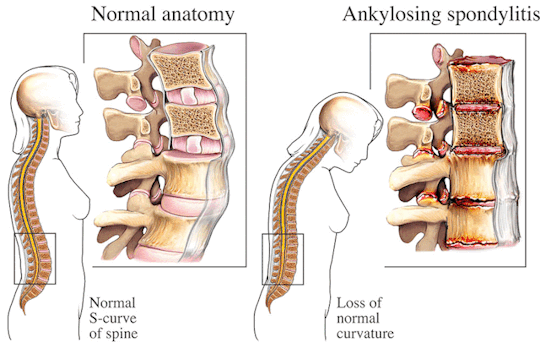
Spondylitis is a comprehensive term used to describe a group of chronic inflammatory diseases that primarily affect the joints of the spine and the sacroiliac region, which includes the pelvis and lower spine. These conditions are characterized by arthritis-like symptoms and can lead to significant discomfort, reduced mobility, and other systemic complications. This detailed exploration will indulge into the nature of spondylitis, how it differs from the related condition known as spondylosis, the various types of spondylitis, diagnostic methods, treatment options, and complementary therapies.
What is Spondylitis?

Spondylitis involves inflammation of the joints, tendons, and ligaments within the spine and sacroiliac region. Tendons are connective tissues that attach muscles to bones, while ligaments connect bones to other bones. This inflammation can result in the fusion of bones (ankylosis) and the formation of new bone, leading to stiffness and reduced flexibility in the spine. In severe cases, excessive bone growth can cause significant curvature of the spine, known as kyphosis.
Spondylitis vs. Spondylosis
While both spondylitis and spondylosis cause pain in the hip and back, they are distinct conditions with different etiologies and characteristics.
Spondylitis is an autoimmune disorder where the immune system mistakenly attacks the joints, causing inflammation, bone fusion, and excessive bone formation. This condition typically develops in teenagers and young adults and can affect multiple organs and systems within the body.
Spondylosis, on the other hand, is a degenerative condition associated with aging and the natural wear and tear of the spine. It involves the degeneration of spinal joints and discs, often accompanied by the formation of bone spurs (osteophytes). Spondylosis primarily affects older individuals, with more than 85% of people over the age of 60 experiencing this condition.
Types of Spondylitis

Medical professionals categorize spondylitis using two primary classification systems: the traditional system and the newer system. The traditional system recognizes six specific types of spondylitis, whereas the newer system categorizes spondylitis into two broad types based on the affected body region.
Traditional Spondylitis Classifications:
a) Ankylosing Spondylitis (AS)
Symptoms: Ankylosing spondylitis primarily affects the spine, causing symptoms such as fatigue, chronic back pain, stiffness, and inflammation in various areas of the body, including joints and tendons. Over time, the vertebrae may fuse, leading to reduced mobility and flexibility.
Causes: The exact cause of AS is unknown, but a strong genetic association exists with the HLA-B27 gene. Approximately 90% of individuals with AS carry this gene, although not all carriers develop the disease.
b) Reactive Arthritis
Symptoms: Reactive arthritis typically presents with a triad of symptoms including arthritis (swelling and pain in joints), conjunctivitis (inflammation of the eyes with a sticky discharge), and urethritis (genital and bladder inflammation with painful urination). However, not all patients exhibit all three symptoms.
Causes: often follows a gastrointestinal infection or a sexually transmitted infection (STI). The immune system overreacts to the initial infection, leading to inflammation and joint pain. The HLA-B27 gene is also strongly linked to ReA, with 30–50% of affected individuals carrying this gene.
c) Psoriatic Arthritis (PsA)
Symptoms: Psoriatic arthritis is associated with the inflammatory skin condition psoriasis. Symptoms include dactylitis (swelling in toes and fingers), changes in nails (such as pitting), eye pain, joint pain, reduced range of motion, and fatigue. PsA typically affects people aged 30–50.
Causes: PsA often follows psoriasis, but it can also develop in individuals without skin symptoms. There is a genetic predisposition to PsA, with at least 10% of the population inheriting genes that increase susceptibility to psoriasis and PsA.
d) Enteropathic Arthritis (EnA)
Symptoms
Enteropathic arthritis is linked to inflammatory bowel diseases (IBDs) such as ulcerative colitis and Crohn’s disease. Symptoms include abdominal pain, bloody diarrhea, and joint swelling and pain.
Causes
The precise cause of EnA is unclear, but it is associated with chronic inflammation in the bowel. This inflammation may allow bacteria to penetrate the bowel wall, triggering an immune response that leads to joint inflammation. The HLA-B27 gene is also linked to EnA.
d) Juvenile Spondyloarthritis (JSpA)
Symptoms
Juvenile spondyloarthritis begins in individuals aged 16 or younger and typically affects the leg joints. Symptoms include joint pain, tenderness, and bowel inflammation.
Causes
Similar to adult spondylitis, JSpA is often associated with the HLA-B27 gene. The exact cause remains unknown, but genetic and environmental factors likely play a role.
e)Undifferentiated Spondyloarthritis (USpA)
Symptoms
USpA is characterized by a variety of symptoms that do not fit neatly into a specific rheumatoid disorder. Symptoms may include persistent lower back pain, joint pain in small and large joints, heel pain, swelling in hands and feet, general stiffness, eye inflammation, rash, urinary tract symptoms, and intestinal inflammation.
Causes
The causes of USpA are diverse and not fully understood. It encompasses a range of symptoms that do not meet the criteria for other specific types of spondylitis.
Newer Spondylitis Categorizations
Peripheral Spondyloarthritis (pSpA)
Peripheral spondyloarthritis affects joints and tendons outside the spine and sacroiliac joints, such as the hands, wrists, elbows, shoulders, knees, ankles, and feet. It includes forms of spondylitis such as reactive arthritis, enteropathic arthritis, and undifferentiated arthritis.
2. Axial Spondyloarthritis (AxSpA)
Axial spondyloarthritis involves inflammation and pain in the pelvis and spine. This category covers a broad range of spondylitis types and includes individuals with and without sacroiliac joint fusion. AxSpA is further subdivided into non-radiographic AxSpA (without visible joint damage on X-rays) and radiographic AxSpA (visible joint damage).
Diagnosis
Diagnosing spondylitis involves abroad approach, combining physical examination, medical history, and various diagnostic tests. There is no single definitive test for spondylitis, making a comprehensive evaluation essential.
a) Physical Examination
During a physical examination, the doctor will assess the patient’s symptoms, medical history, and family history of autoimmune diseases such as psoriasis and spondyloarthritis. The examination may include evaluating joint tenderness, swelling, and range of motion.
b) Diagnostic Tests
Blood Tests: Blood tests can help identify markers of inflammation, such as elevated erythrocyte sedimentation rate (ESR) and C-reactive protein (CRP). Testing for the presence of the HLA-B27 gene can also provide valuable information, although not all individuals with spondylitis carry this gene.
Imaging Tests: Imaging techniques are crucial for diagnosing spondylitis and assessing the extent of joint and bone damage.
X-rays: X-rays can reveal changes in the spine and sacroiliac joints, such as joint fusion and bone spurs.
MRI Scans: MRI scans provide detailed images of soft tissues and can detect early signs of inflammation and joint damage that may not be visible on X-rays.
Ultrasound Scans: Ultrasound scans can be used to assess inflammation in peripheral joints and tendons.
Genetic Testing: Testing for the HLA-B27 gene can support the diagnosis, particularly in cases where clinical symptoms and imaging findings are inconclusive.
Treatment
While there is no cure for spondylitis, various treatments can help manage symptoms, reduce inflammation, and improve the patient’s quality of life. Treatment plans are often tailored to the individual’s specific symptoms and disease severity.
Medications
Nonsteroidal Anti-Inflammatory Drugs (NSAIDs): NSAIDs are commonly used to reduce inflammation and pain in spondylitis patients. Examples include ibuprofen and naproxen.
Corticosteroids: Corticosteroids, such as prednisone, can be prescribed for short-term use to control severe inflammation and pain.
Disease-Modifying Antirheumatic Drugs (DMARDs): DMARDs, including methotrexate and sulfasalazine, can help manage symptoms and slow disease progression in some types of spondylitis.
Biologic Agents: Biologic agents, such as tumor necrosis factor (TNF) inhibitors (e.g., adalimumab, etanercept) and interleukin-17 (IL-17) inhibitors (e.g., secukinumab), target specific components of the immune system to reduce inflammation and prevent joint damage.
Analgesics: Pain relievers, such as acetaminophen, may be used to manage pain when inflammation is not the primary issue.
Physical Therapy
Physical therapy plays a crucial role in managing spondylitis by improving and maintaining spine flexibility and overall mobility. Techniques may include:
Massage Therapy: Therapeutic massage can help reduce muscle tension, improve circulation, and alleviate pain.
Spinal Manipulation: Performed by a trained physical therapist or chiropractor, spinal manipulation can enhance mobility and reduce pain.
Exercises: Tailored exercise programs can help strengthen muscles, improve posture, and enhance flexibility. Stretching exercises are particularly beneficial for maintaining spine and joint flexibility.
Breathing Exercises: Breathing exercises are essential for individuals with ankylosing spondylitis, as the condition can affect chest expansion and respiratory function. These exercises help maintain normal lung function and prevent restrictive lung disease.
Surgery: Surgery is generally considered a last resort and is reserved for severe cases where conservative treatments have failed. Surgical options include:
Joint Replacement: For patients with severe joint damage, joint replacement surgery (e.g., hip or knee replacement) can restore function and relieve pain.
Spinal Surgery: In cases of severe spinal deformity or nerve compression, spinal surgery may be necessary to correct curvature and alleviate pressure on nerves.
Complementary Therapies
In addition to conventional treatments, complementary therapies can provide additional symptom relief and improve overall well-being. These therapies are often used alongside standard medical treatments.
Massage Therapy: Massage therapy can help reduce muscle tension, improve blood circulation, and alleviate pain and stiffness in the affected areas.
Relaxation Techniques: Techniques such as deep breathing, progressive muscle relaxation, and meditation can help manage stress and reduce pain perception.
Yoga: Yoga combines physical postures, breathing exercises, and meditation to improve flexibility, strength, and relaxation. Yoga can be particularly beneficial for maintaining spine flexibility and reducing pain.
Acupuncture: Acupuncture involves the insertion of thin needles into specific points on the body to stimulate the nervous system and promote natural pain relief and healing.
Cupping: Cupping is a traditional therapy that involves placing suction cups on the skin to improve blood flow and reduce muscle tension. It can be used to alleviate pain and stiffness in the back and other affected areas.
Summary
Spondylitis encompasses a range of chronic inflammatory diseases that affect the spine and sacroiliac region. It is characterized by autoimmune-driven inflammation, leading to joint pain, stiffness, and potential bone fusion. Spondylitis is distinct from spondylosis, a degenerative condition associated with aging. Medical professionals classify spondylitis into various types based on symptoms and affected body regions. Diagnosis involves a combination of physical examination, medical history, blood tests, imaging, and genetic testing. While there is no cure, treatments such as medications, physical therapy, and complementary therapies can help manage symptoms and improve the quality of life for those affected by spondylitis. By understanding the nature of spondylitis and the available management strategies, individuals can better navigate their condition and maintain an active, fulfilling life.
Medical students and healthcare professionals need to stay informed about the latest advancements in diagnosing and treating spondylitis. Continuous education and expert guidance are crucial for managing these complex conditions. For additional support with challenging medical units, clinical studies, research projects, assignments, and exam preparation, Expert Academic Assignment Help offers professional resources and online classes. For personalized assistance, contact [email protected] Accessing expert guidance can significantly enhance your understanding and proficiency in medical education.
#medical students#assignment help#nursing school#nursing student#medicine#healthcare#student life#medical student#studyblr#case study#student#online writing#do my online class#essay writing#phd research#clinical research#research#phd thesis writing service#phdjourney#phd life#phdblr#studying#study blog#study motivation#studyspo#study aesthetic
5 notes
·
View notes
Text
Is Your Dissertation Deadline Looming? We Can Help.

Facing a dissertation deadline that feels closer than your next cup of coffee? Fear not, dedicated scholar! At Dissertation Writing Help for Students, we’ve encountered every scenario: from those unfamiliar with the Dewey Decimal System to those pondering quirky research topics like “Why My Cat Stares at Me Like I Owe Him Money.”
We offer a range of services to transform your work from “frantic scribbling” to “doctoral triumph”:
Last-Minute Editing: Did you accidentally use Comic Sans for your entire Methods chapter? We can fix that and ensure your document meets academic standards.
Dissertation Completion Support: Need someone to take over while you get some much-needed rest? We’ll handle the heavy lifting, allowing you to focus on celebrating your accomplishments.
Early-Stage Guidance: Overwhelmed by a sea of research papers? We’ll provide clear direction, guiding you towards academic success.
Our team of experienced professionals has the expertise to turn your dissertation into a masterpiece. Don’t waste another minute stressing about formatting or your Literature Review. We’ve got your back.
Investing in your academic future with Dissertation Writing Help For Students means choosing a dedicated professional who understands the complexities of dissertation writing and is committed to your success. With a comprehensive range of services, personalized attention, and a proven track record of helping students achieve their academic goals, I am here to support you at every stage of your dissertation journey.
Feel free to reach out to me at [email protected] to commence a collaborative endeavor towards scholarly excellence. Whether you seek guidance in crafting a compelling research proposal, require comprehensive editing to refine your dissertation, or need support in conducting a thorough literature review, I am here to facilitate your journey towards academic success.
#education#academics#grad school#gradblr#phd#phd life#phd research#phd student#phdblr#study#study motivation#studyblr#studying#studyspo#study blog#student#study aesthetic#academic#university#study notes#studyblr community#study desk#study with me#university student#essay writing#essay help#assignment help#assignmentwriting#assignment services#academic assignments
0 notes
Text

Are You Planning to Study Abroad? Let Thinkovity be your guide! Our experienced writers ensure your application reflects your aspirations and achievements.
Our Services :
Statement of Purpose (SOP)
Study Gap Explanation Letter
Source of Fund Explanation Letter
Letter of Motivation (LOM)
Letter of Recommendation (LOR)
CV/Cover Letter Ready to make your writings shine? Contact us soon
WhatsApp: +44 7456 000639
#statement of purpose#sop#letter of recommendation#assignment services#assignment help#thesis#dissertation writing#creative writing#academic writing#phd#dissertation
0 notes
Text
Best Dissertation Acknowledgements
Writing With Examples

You can learn how to write dissertation acknowledgments with examples to express gratitude to those who supported your academic journey.
#Best Dissertation acknowledgment examples#dissertation acknowledgment#PhD dissertation acknowledgement#writing acknowledgement for the dissertation#dissertation help#assignment expert help
1 note
·
View note
Text

Expert PhD Writing Assistance offers comprehensive support for doctoral students, ensuring scholarly excellence in their theses and dissertations through meticulous research, precise analysis, and proficient writing. text in: https://wa.me/917695915125
Visit : https://expertphdwriting.com
#phd life#phd writing service#phd research#dissertation#thesis#scopus#spss#phd#phd student#assignment help
1 note
·
View note
Text

#language#teacher#studyspo#studyblr#studying#study motivation#teaching#student life#textbooks#100 days of productivity#assignment help#assignment services#assignment 3#assignment writing#college#students#school#university#assignment website#phd
0 notes
Text

#language#teaching#studyspo#studyblr#studying#study motivation#teacher#textbooks#100 days of productivity#student life#assignmentexperts#assignmentwriting#assignment help#academic assignments#assignment services#university#students#college#school#phd#assignment writing help#assignment writing service#assignment writers#assignment website#assignment writer#assignment writing#assignment 3#online assignment help#homework help#online assignment expert
0 notes
Text

writing a thesis is a hell lot of work. But availing an Expert thesis Writing Service is NOT ! 24*7 assistance, custom paper writing, expert research, AI proof content, what else.
Get your thesis paper done by the best expert writers.
#thesis writing service#best thesis help#academic assignments#uk#thesis paper help online#phd thesis students
0 notes